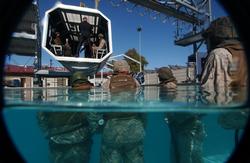General Training Systems
“A” Schools
Providing the fleet with 15,000 Navy and Marine students yearly.
The "A" schools are designed to provide the Sailors and Marines with the knowledge and skill levels required to perform as technicians at the third class petty officer level. The backbone of Naval Aviation was trained in the "A" school.
Delivering Curriculum based Blended Training Solutions composed of:
- Integrated Media Instruction
- Electronic Classrooms
- PC- Simulations
- Training Devices
Naval Aviation Survival Training Program
The Naval Aviation Survival Training Program (NASTP) provides initial and refresher survival training to Navy and Marine Corps aircrew and selected DoD personnel in support of Seapower 21’s Seastrike pillar. Training includes aeromedical aspects of flight, water survival skills, proper employment of Aviation Life Support Systems (ALSS) and additional survival procedures in accordance with OPNAVINST 3710.7 Series.
Landing Signal Officer
The Landing Signal Officer (LSO) Trainer, Device 2H111
- Located at the LSO School at NAS Oceana, Va.
- Supports training for the Initial Formal Ground Training (IFGT) course, Advanced Formal Ground Training (AFGT) course, and the Fleet Replacement Squadron (FRS) Training Command (FRS/TRACOM) course.
The 2H111 provides a safe, controlled environment for concentrated, hands-on LSO training (individually and team training) without endangering aircraft, personnel, or flight support equipment. The 2H111 allows LSO trainees to practice coordination procedures as well the introduction to the complex concepts involved in the recover of combat aircraft aboard an aircraft carrier. The 2H111 possesses the capability to simulate a wide variety of emergency conditions and malfunctions as required by the training scenario and to accommodate the level and complexity required for the training being conducted.
Landing Signal Officer Computer Based Trainer
The objective of the LSOCBT is to support the training objectives of the Initial Formal Ground Training course. The trainer consists solely of Commercial-Off- the-Shelf components, including a Central Control Complex and 16 student stations that are networked together. Central to this system is the interactive courseware that is inherent in the training system, including a courseware authoring capability. Ten lessons are available, including lessons pertaining to glide slope geometry, effects of wind, aircraft characteristics, FLOS/LSO equipment, field arresting gear, shipboard arresting gear and steam catapults.
Air Traffic Control
Air Traffic Control (ATC) Training System Support
The Tower Operator Training System (TOTS) provides training for Navy and Marine Air Traffic Control (ATC) trainees in a full immersion, high fidelity, simulated control tower environment. The TOTS provides a safe, controlled environment for concentrated, hands-on ATC training without endangering aircraft, personnel, or flight support equipment.
The Carrier Air Traffic Control Center (CATCC) / Amphibious Air Traffic Control Center (AATCC) simulator provides high fidelity training for Navy Air Traffic Control (ATC) trainees in a realistic shipboard air traffic control environment. The simulator provides a safe, controlled environment for concentrated, hands-on ATC training without endangering aircraft, personnel, or flight support equipment.
The simulator is used to introduce shipboard ATC concepts to all levels of ATC specialist as well as provide “Team Training” to qualified ATC specialist assigned to deployable units allowing them to fine tune their skills and to function in a team environment without jeopardizing life or property during extended in-port periods.
The Radar Simulator provides basic and advanced Air Traffic Control Radar operations training for U.S. Navy and U.S. Marine Corps Air Traffic Control (ATC) trainees in a realistic ATC Radar environment. The Radar Simulator provides a safe, controlled environment for concentrated, hands-on ATC training without endangering aircraft, personnel or flight support equipment. The versatility of the Radar simulator allows it to be used to teach both basic fundamentals to entry level personnel as well as advanced instruction in terminal radar approach control procedures to more experience ATC specialist.
ATCS/ASM
The future of training readiness.
The Aviation Maintenance Training Continuum System (AMTCS) was initiated in order to:
- Improve readiness
- Enhance safety
- Reduce training and administrative time and cost
Advanced Skills Management (ASM) was developed to support training and readiness using task-based methodologies.
ASM is an integrated, object-oriented, web-based system that provides the ability to manage training requirements for technicians and administrative personnel.
- Creates both short and long-term, detailed, individual, or group training plans Assigns and tracks progress toward attainment of any type of qualification/certificate or license Provides powerful reports allowing maintenance managers the ability to review organizational readiness to perform maintenance.
- Allows work center and line supervisors the ability to schedule daily maintenance activities with full visibility of up-to-date technician qualifications.
- Gives individuals the ability to see their assigned training activities and easily track their progress.
Mobile Aircraft Firefighting Training Device
The Mobile Aircraft Firefighting Training Device (MAFTD) provides realistic firefighting scenarios for civil service, military and civilians, ashore or afloat. The MAFTD limits the amount of pollutants former firefighting simulators used to exude into the atmosphere since it is fueled by propane. It resembles a large aircraft and loaded with the capabilities to emulate wheel fires, engine fires, ordnance fires, cockpit fires, etc.



